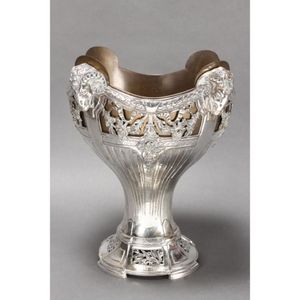Neo-Classical German Silver Centrepiece with Ram Heads
You must be a subscriber, and be logged in to view price and dealer details.
Subscribe Now to view actual auction price for this item
When you subscribe, you have the option of setting the currency in which to display prices to $Au, $US, $NZ or Stg.
- Floral Swag / Garland / Festoon - Floral swags are a decorative motif often used in the ornamentation of various objects, such as silverware, glassware, and furniture. The term "swag" refers to a garland or wreath of flowers, foliage, or other decorative elements, which is usually arranged in a loop or curve.
Floral swags can be found in a variety of decorative styles, from ornate Baroque and Rococo designs to more naturalistic Art Nouveau and Art Deco styles. They are often used to add a touch of elegance, refinement, or whimsy to an object, and can be seen on a range of items from chandeliers and candlesticks to picture frames and tea sets.
In the decoration of silver objects, floral swags are often used to accentuate the curves and lines of the piece, and to add visual interest to the surface. Similarly, on glass objects, floral swags may be used to frame or highlight a particular area of the object, or to add a touch of color and delicacy.
On furniture, floral swags can be found on a variety of pieces, from cabinets and armoires to chairs and sofas. They are often used to enhance the lines and curves of the furniture, and can be used to create a sense of movement and flow in the design.
Overall, floral swags are a versatile decorative element that can be adapted to a range of styles and applications, and have been used in the decoration of various objects throughout history. - Neo Classical - The period or style, known as "neo-classical", was based on Greek and Roman designs and motifs, and is usually associated with the influence of the four Adam brothers, but principally Robert Adam, the second oldest of the brothers, who were architects and designers, active in the latter half ot the 18th century (1760s to 1790s).
Born in Scotland in 1728, Robert Adam spent time in Italy studying and his designs are influenced by the finds made during the excavation of Pompei.
When he returned to England he became the Court Architect to George III (1738-1820).
In turn, designs by Adam then influenced Hepplewhite.
Neo-classical ornamentation is characterised by use of classical urns, palmettes, mythical creatures such as the sphinx and griffin, ram's heads, swags, scrolling foliage, and use of the Greek key pattern.
This item has been included into following indexes:
Visually similar items

Two Edward VII sterling silver oval floral pierced baskets by George Nathan & Ridley Hayes, Chester 1907 & 1911 inset with four silver shillings, two 1745 and two 1758, and a smaller matching bowl inset with four silver 6 pence pieces, 1787, 27 & 16 cm wid

A pair of Oriental silver vases, early 20th century, the lead weighted vases of baluster form with fluted rims, upon a socle and a circular rimmed foot, embossed with frieze like bands of oriental figures in a range of mystic poses and landscape settings a

George III heavy sterling silver water ewer vase shape with wide lip, scroll handle, raised band, London, 1776, maker, John Kentesber

A German Continental silver tazza. Post 1886 Veiburg or Weimar, crescent and Crown mark and with maker's mark S.K, the quatrefoil lobed and pierced bowl with an undulating leaf and floral embellished rim above a waisted pedestal to a spreading base also pi
